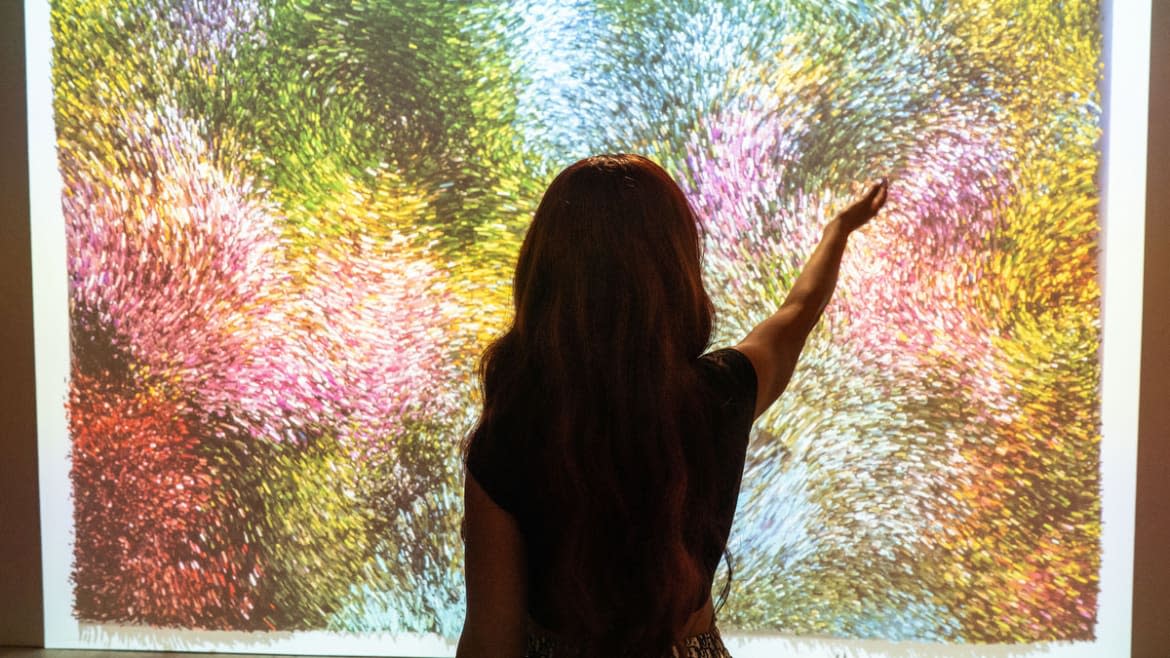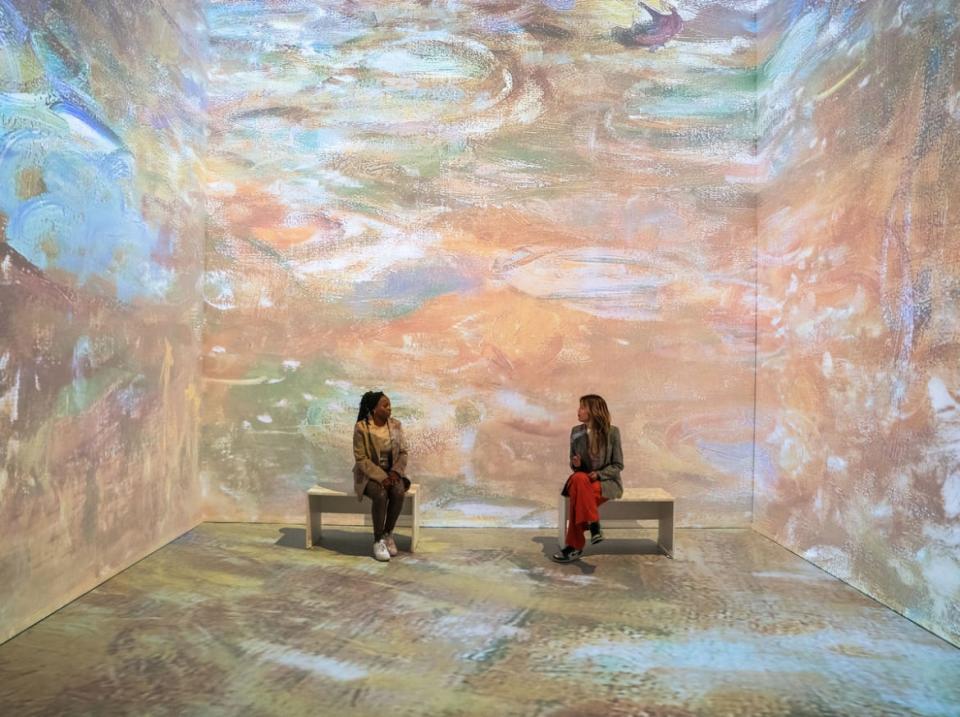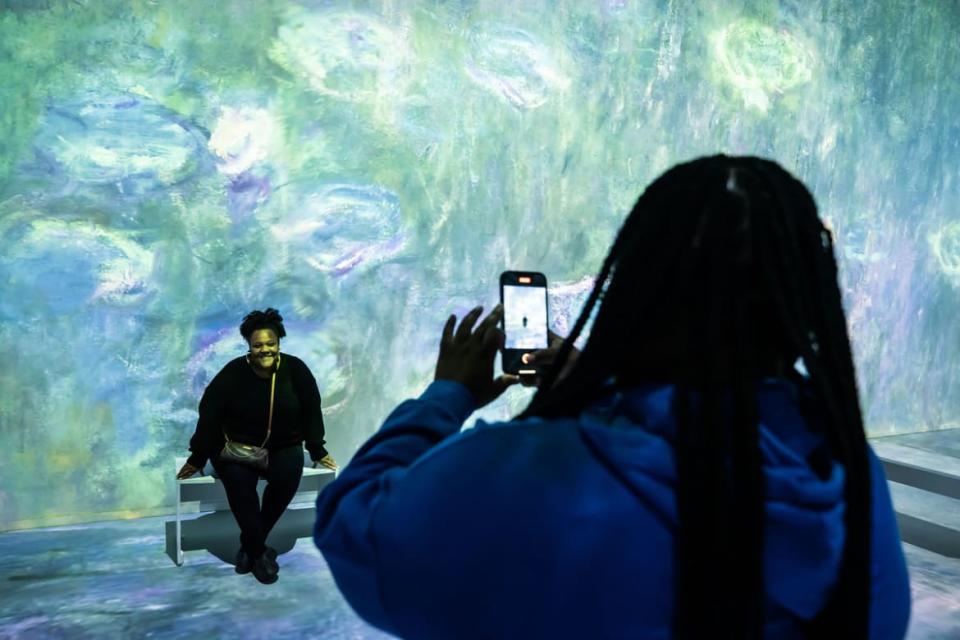‘Monet’s Garden: The Immersive Experience’ Is Trying a Little Too Hard

- Oops!Something went wrong.Please try again later.
After forking over $40 for a ticket for one adult, a middle-aged blonde woman in a maroon cardigan was hovering by a scanner that was converting outlines of the flowers and lily pads she’d just colored in with markers into digital artwork.
Next to the scanner, draped in and surrounded by fake flowers, was a life-sized reproduction of the famed Japanese bridge the Impressionist painter Claude Monet lovingly depicted in his iconic, beloved paintings of water lilies. After a beat, the woman’s water lily design popped up on the pond-shaped blue screen installed beneath the bridge and began to drift languidly around.
“I feel like I’m back in kindergarten!” she exclaimed, which was an apt summation of the innocuous sweetness of the overall vibe.
When Claude Monet Slashed and Destroyed His Own Paintings
Amidst the tightly packed skyscrapers that make up Lower Manhattan, Seamen’s Bank Building is currently playing host to the pastel fantasia that is Monet’s Garden: The Immersive Experience, the latest in a succession of immersion playgrounds to crop up in the aftermath of 2021’s series of dueling immersive Van Gogh exhibitions. This fall, New York City will also welcome immersive King Tut, Encanto and Gustav Klimt exhibitions, which begs the question: What can’t become an immersive exhibition?
The blockbuster Van Gogh ventures certainly weren’t the first platforms to capitalize on immersive programming, but they've been wildly successful. Lighthouse Immersive, the company behind “Immersive Van Gogh,” collected around $250 million in ticket revenue from that show in addition to $30 million in gift shop sales, producer Corey Ross told MarketWatch last December.
Monet’s Garden is the result of a collaboration between the Swiss creative labs Immersive Art AG and Alegria Konzert GmbH; unlike the hallowed halls of a museum, immersive exhibitions are designed to delight their audiences without evoking sour feelings of intimidation.
“Today, you don’t get to inform your visitors without entertaining them,” Dr. Nepomuk Schessl, the producer of Monet’s Garden, told The Daily Beast. “Monet himself painted the waterlily decorations in such a big format because he wanted the spectator to feel submersed in them,” Schessl said, adding that Monet’s Garden was already in production before immersive Van Gogh exhibitions became successful. “This is a logical next step.”

Towards the end of his life, Monet settled down in the French village of Giverny to focus on improving his art and cultivated a Japanese garden complete with a pond next to his farmhouse that became the inspiration for the Instagram-optimized environment in which I now sit.
Monet ultimately spent 30 years making paintings inspired by the water lilies in his garden, many of which are housed in the Orangerie Museum in Paris. Water lilies speckle nearly every object offered for sale in the Monet Experience gift shop, down to the $10 handheld fans and $35 scented candles.
The showstopper element of the Monet experience is at the ground level of the bank building. After being handed a pillow for seating, visitors enter a cavernous space constructed out of massive screens (everywhere except for the ceiling) and experience a 45 minute, enthusiastically narrated visual speed-run through the artist’s creative eras, personal troubles and evolving aesthetic tastes.
“When I look at a Monet picture it feels immersive, it’s about the light and your ability to lose yourself, and it doesn’t feel like that here,” Gary, a big Monet fan and a marathon runner visiting from London, told The Daily Beast.
While on some level this author appreciated the rousing music and shapeshifting graphics which added flourishes to the melting slideshow of Monet’s work, at times the show felt rather like being stuck inside a very loud Wikipedia page.
After mounting an escalator, the second floor reveals a floor carpeted in artificial green turf. Every wall is coated in fake greenery and more fake flowers drip over several green park benches, while swirling digital animations of Monet’s paintings flicker on the wall.
Around the corner you’ll find the Instagram-friendly bridge and scanning station as well as a number of scannable QR codes that launch AI versions of Monet paintings on your Instagram story and a cluster of small gallery where the bullet point highlights of Monet's life and career are written out next to smaller reproductions of his paintings. The scents of lavender and water lilies are being discreetly pumped into the room.
In one room next to the Japanese bridge, if you dance on a certain spot indicated on the floor, a screen full of swirling colors responds to your movements, creating a charming visual effect. In another corner, another body-detecting installation transforms your figure into a flurry of colorful pixels that writhes and transforms as you move; every kid who I saw interact with it loved it.
Camila Diaz, an 18-year-old freshman at Columbia University, visited the Monet exhibition on Monday with two friends. Diaz had loved the immersive Van Gogh installation she’d been to last year, and was planning to go to the immersive Klimt experience too.

“The explanations of Monet’s life and his personal history were really well done, but I would liked to have seen more paintings around,” Diaz told The Daily Beast. “But the exhibition is really pretty and it really captures the essence of the garden. I love Monet, he’s my favorite painter and his art is so calming.”
“If you see Monet’s paintings from far away, you have another perspective,” a Marina, a 48-year-old visitor from Montevideo, Uruguay, told The Daily Beast.
This is perhaps part the problem with building an immersive exhibition around Monet’s work. When 40-foot-tall reproductions of his haystacks are inches from your nose, in my opinion, they kind of just look like blobs, meaning that viewing his work at a distance is the optimal choice.
When I put this criticism to Dr. Schessl, he reiterated previously mentioned points. “Monet himself painted his waterlily decorations in such large formats already, as they are displayed in the Orangerie in Paris for example, because he wanted the spectator of his art to be surrounded and submerged with the motif and become one with it. Immersion was already part of his very own concept. The modern possibilities of an immersive installation like this seem like a very logical and consistent next step in the way to present his art.”
However, for this author the Monet exhibition didn’t feel as impactful as simply standing in front of his paintings as they are, and letting the effect wash over you.
Get the Daily Beast's biggest scoops and scandals delivered right to your inbox. Sign up now.
Stay informed and gain unlimited access to the Daily Beast's unmatched reporting. Subscribe now.

